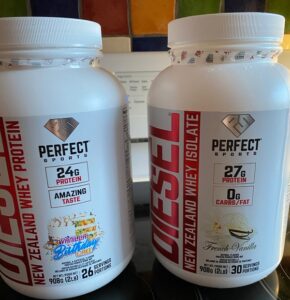I have been having lots of conversations lately around getting enough protein as we age!
One thing that always comes up is supplementation. I do think getting your protein from whole food is important, but that doesn’t mean some supplementation is bad.
Disclaimer – If you are eating in a way you like and it is working for you, great! I’m not here to tell you need protein supplementation, you may not. Tracking for one or two days should give you an idea of how much you are getting with food. Keep in mind the experts say about 100 grams a day is best for older people who want to retain mucsle mass.
If your goals are gaining or retaining lean muscle mass or body recomposition, you might have to supplement to get that much. You also have to have the stimulus of resistance training of course. Here is a study summary that looked at low, medium and higher protein intakes in post menopausal women and showed how a higher protein intake resulted in better outcomes.
Whey protein powder is a powerful supplement since it has the right amino acid profile for building muscle. Plant protein powders are also good (I love using this one in my oatmeal) but whey is the gold standard. It can be taken in a shaker bottle with water or in a smoothie. Some people even ‘bake’ with it!
Often people ask me what the ‘best’ protein powder is to buy. It is a tough question since everyone’s personal tastes are so – well – personal. 🙂 Here are three things to look for on the label of protein powders when you are buying one.
1. Are you looking for flavored or unflavored?
If you get a flavored powder it will be sweetened with something and probably not with sugar. It will likely be Sucralose or Stevia. There is no evidence that either of these things are harmful, but if you don’t like the taste of artificial sweeteners you won’t like the Sucralose sweetened ones. There are some with Stevia that are de-bittered that I think taste pretty good but again – personal taste. The only downside to unflavored is that it may be bland so you could sweeten it yourself or use it in a smoothie with other flavors. This one looks good but you can find others at grocery stores and drug stores.
2. What is the ratio of calories to protein grams?
When you look at the label, how many calories and how much protein are you getting? Here are two versions of Diesel protein – one has less protein and more calories but they look very similar.

3. What is the cost per serving?
This can also be confusing – with the above example, one has more servings than the other. The one on the left with fewer servings is the cheaper one but perhaps not necessarily a good value. It also says amazing taste but I don’t like it. The one on the right with 27 grams of protein is pretty good but it is much more expensive.
Someone told me if you buy at GNC they will let you bring it back if you don’t like it, so check that out if that is appealing to you. You can also find good ones on sale sometimes at the grocery store if you know what you are looking for.
Have you found a protein supplement you enjoy? leave it in the comments below!

I like Vega and buy it on sale usually at Safeway 15% off days. One 518 g container for about $25 lasts about a month.The coconut almond is a favorite, sweetened with Stevia and one scoop goes into the morning smoothie. I find that the more protein I can start my day with, the more energy I have throughout the day. About $1/ protein serving of 20g, it is also very cost-effective as I am trying to increase my protein intake (versus the cost of chicken breasts or salmon).
Thank you for this- What a great tip! Yes – protein in the form of lean meat is super expensive 🙂